Ribeye steak, ah, the king of steaks! Are you ready to unlock the secrets to a perfectly seared, melt-in-your-mouth ribeye that will rival any steakhouse experience? I’m going to guide you through a simple yet effective method to achieve steak nirvana, right in your own kitchen.
The allure of a good steak has captivated food lovers for centuries. While the exact origins are debated, the appreciation for expertly cooked beef dates back to ancient civilizations. The ribeye cut, specifically, is prized for its rich marbling, which renders during cooking, creating an unparalleled depth of flavor and tenderness. It’s a cut that speaks of indulgence and celebration.
But why is the ribeye steak such a beloved choice? It’s the perfect combination of robust beefy flavor and a luxuriously tender texture. The generous marbling ensures that each bite is juicy and flavorful, preventing the dryness that can plague leaner cuts. Plus, it’s surprisingly versatile! Whether you prefer it grilled, pan-seared, or even cooked sous vide, a ribeye steak is a guaranteed crowd-pleaser. Let’s get cooking!
Ingredients:
- 2 (12-16 ounce) Ribeye Steaks, about 1.5 inches thick
- 2 tablespoons Olive Oil, extra virgin
- 2 tablespoons Unsalted Butter
- 4 cloves Garlic, minced
- 2 sprigs Fresh Rosemary
- 2 sprigs Fresh Thyme
- 1 teaspoon Kosher Salt, or to taste
- 1 teaspoon Black Pepper, freshly ground, or to taste
- Optional: 1/4 cup Beef Broth or Red Wine (for deglazing the pan)
Preparing the Steaks:
Okay, let’s get started! The key to a perfect ribeye is all in the preparation. Trust me, taking these steps will make a world of difference.
- Pat the Steaks Dry: This is crucial! Use paper towels to thoroughly pat both sides of the ribeye steaks dry. Removing excess moisture allows for a beautiful sear. A dry steak sears, a wet steak steams. We want a sear!
- Season Generously: Don’t be shy with the salt and pepper! Season both sides of the steaks liberally with kosher salt and freshly ground black pepper. I like to use a generous amount it really brings out the flavor. Make sure the seasoning is evenly distributed.
- Let the Steaks Rest: This is where patience comes in. Place the seasoned steaks on a wire rack set over a baking sheet. This allows air to circulate around the steaks. Let them rest at room temperature for at least 30 minutes, or even up to an hour. This allows the salt to penetrate the meat and helps the steaks cook more evenly. Don’t skip this step! It’s a game-changer.
Cooking the Steaks:
Now for the fun part! We’re going to get that gorgeous crust and perfectly cooked interior. There are a few ways to cook a ribeye, but I’m going to walk you through my favorite method: searing in a skillet followed by basting with butter, garlic, and herbs.
- Heat the Skillet: Place a heavy-bottomed skillet (cast iron is ideal) over high heat. Let it get screaming hot! You want it to be almost smoking. This is essential for achieving a good sear.
- Add the Oil: Once the skillet is hot, add the olive oil. The oil should shimmer and be ready to go.
- Sear the Steaks: Carefully place the steaks in the hot skillet, making sure not to overcrowd the pan. If your skillet isn’t large enough, cook the steaks in batches. Sear the steaks for 3-4 minutes per side, without moving them. You want a deep, dark brown crust to form. Resist the urge to peek or move them around! Let them do their thing.
- Reduce the Heat and Add Butter, Garlic, and Herbs: After searing both sides, reduce the heat to medium. Add the butter, minced garlic, rosemary sprigs, and thyme sprigs to the skillet.
- Baste the Steaks: Tilt the skillet slightly and use a spoon to continuously baste the steaks with the melted butter, garlic, and herb mixture. This infuses the steaks with incredible flavor and helps them cook evenly. Baste for about 2-3 minutes per side, or until the steaks reach your desired level of doneness.
- Check the Temperature: Use a meat thermometer to check the internal temperature of the steaks. Here’s a guide for doneness:
- Rare: 125-130°F
- Medium-Rare: 130-135°F
- Medium: 135-145°F
- Medium-Well: 145-155°F
- Well-Done: 155°F+ (I don’t recommend this for ribeye!)
Remember that the internal temperature will continue to rise slightly as the steaks rest, so remove them from the skillet a few degrees before they reach your desired doneness.
- Optional: Deglaze the Pan: After removing the steaks, you can deglaze the pan to make a simple pan sauce. Pour in the beef broth or red wine and scrape up any browned bits from the bottom of the skillet. Let the sauce simmer for a minute or two, until it thickens slightly.
Resting and Serving:
Almost there! Resting the steaks is just as important as the cooking process. It allows the juices to redistribute throughout the meat, resulting in a more tender and flavorful steak.
- Rest the Steaks: Transfer the steaks to a clean cutting board and tent them loosely with foil. Let them rest for at least 10 minutes, or even up to 15 minutes. Don’t skip this step! It’s crucial for a juicy steak.
- Slice and Serve: After resting, slice the steaks against the grain into 1/4-inch thick slices. This makes them easier to chew and enhances their tenderness.
- Serve with Pan Sauce (Optional): If you made a pan sauce, drizzle it over the sliced steaks.
- Garnish and Enjoy: Garnish with fresh herbs, such as rosemary or thyme, and serve immediately. Some great side dishes to pair with ribeye steak include mashed potatoes, roasted vegetables, or a simple salad.
Tips for the Perfect Ribeye:
Here are a few extra tips to ensure your ribeye is a masterpiece:
- Choose the Right Steak: Look for ribeye steaks that are well-marbled with fat. The fat is what gives ribeye its rich flavor and tenderness.
- Don’t Overcrowd the Pan: If you’re cooking multiple steaks, cook them in batches to avoid overcrowding the pan. Overcrowding will lower the temperature of the skillet and prevent the steaks from searing properly.
- Use a Meat Thermometer: A meat thermometer is the best way to ensure your steaks are cooked to your desired level of doneness.
- Don’t Be Afraid of the Heat: High heat is essential for achieving a good sear. Don’t be afraid to crank up the heat!
- Let the Steaks Rest: I can’t stress this enough! Resting the steaks is crucial for a juicy and tender steak.
- Experiment with Flavors: Feel free to experiment with different herbs and spices. Garlic powder, onion powder, paprika, and chili powder are all great additions to ribeye steak.
- Reverse Sear Method: For an even more controlled cook, consider the reverse sear method. Bake the steaks at a low temperature (around 250°F) until they are almost to your desired internal temperature, then sear them in a hot skillet to develop a crust.
- Dry Brining: For even better flavor and moisture retention, try dry brining the steaks. Season them with salt 12-24 hours before cooking and let them sit uncovered in the refrigerator. This allows the salt to penetrate the meat and draw out moisture, which then reabsorbs, resulting in a more flavorful and juicy steak.
- Don’t Wash the Steak: I know some people do this, but washing the steak is unnecessary and can actually spread bacteria. Just pat it dry with paper towels.
- Use a High Smoke Point Oil: Olive oil is fine, but avocado oil or grapeseed oil have higher smoke points and are better suited for high-heat searing.
Troubleshooting:
Sometimes things don’t go exactly as planned. Here are a few common problems and how to fix them:
- Steak is Tough: This could be due to overcooking, undercooking, or not resting the steak properly. Make sure to use a meat thermometer and let the steak rest for at least 10 minutes.
- Steak is Not Seared Properly: This could be due to not using high enough heat or overcrowding the pan. Make sure the skillet is screaming hot and cook the steaks in batches if necessary.
- Steak is Overcooked on the Outside and Undercooked on the Inside: This could be due to using too high of heat for too long. Reduce the heat after searing and baste the steaks with butter to help them cook evenly. Consider the reverse sear method for more even cooking.
- Pan is Smoking Too Much: This could be due to using an oil with a low smoke point or having the heat too high. Use an oil with a high smoke point and reduce the heat slightly if necessary.
- Steak is Bland: This could be due to not seasoning the steak generously enough. Don
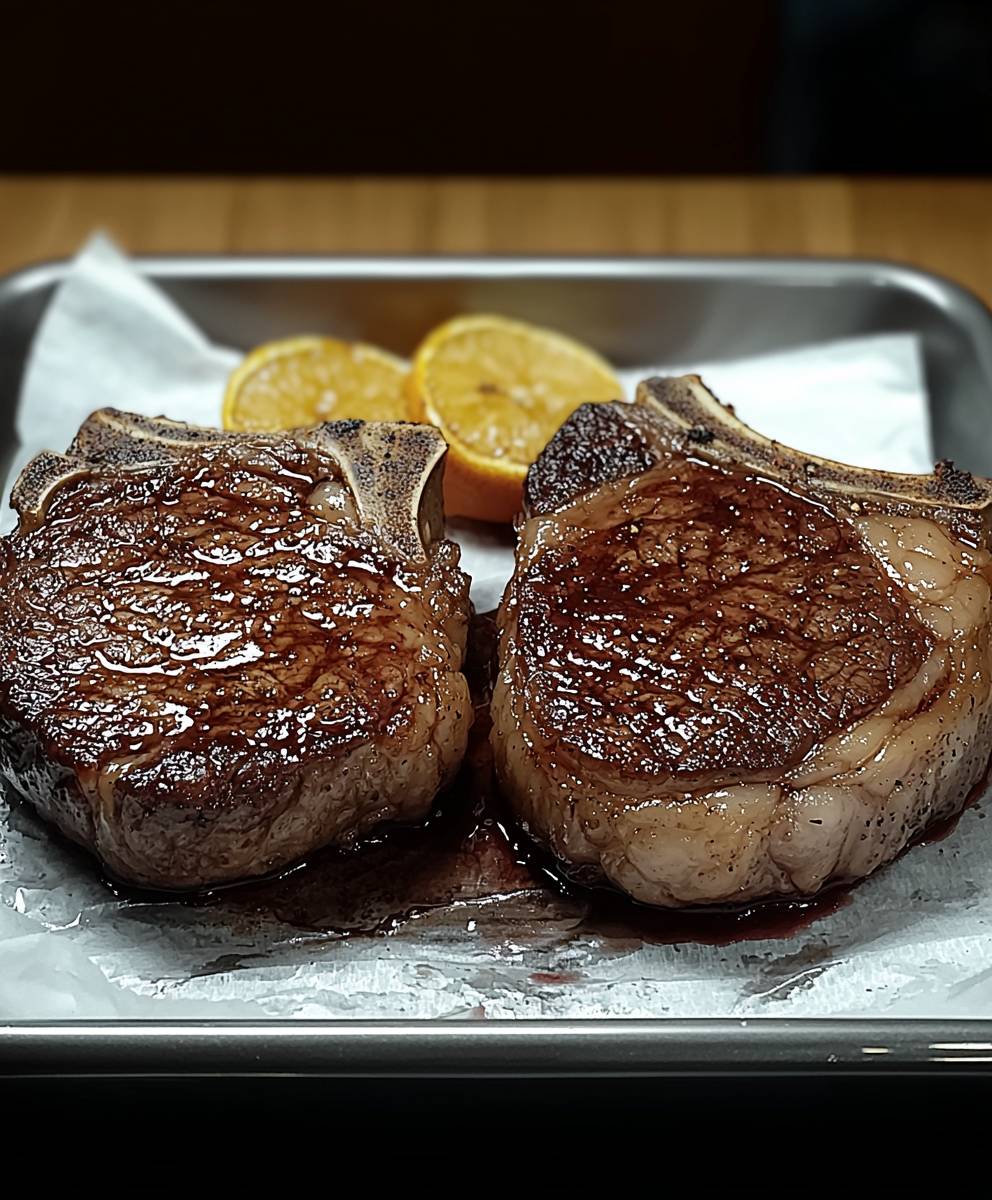
Conclusion:
So, there you have it! This isn’t just another steak recipe; it’s a gateway to experiencing ribeye in its most glorious form. The simple yet effective techniques we’ve covered unlock a depth of flavor and tenderness that will have you questioning every steak you’ve ever had before. Trust me, the sear alone is worth the effort, creating a beautiful crust that gives way to a juicy, perfectly cooked interior. This method consistently delivers restaurant-quality results, right in your own kitchen.
But why is this ribeye steak recipe a must-try? Because it’s foolproof! We’ve broken down each step, ensuring that even novice cooks can achieve steakhouse perfection. It’s also incredibly versatile. While we’ve focused on a classic preparation, the possibilities are endless. Feel free to experiment with different herbs and spices in your marinade or compound butter. A sprig of rosemary and a clove of garlic added to the pan during the sear will infuse the steak with even more aromatic goodness. Or, for a spicy kick, try adding a pinch of red pepper flakes to your seasoning blend.
Serving Suggestions and Variations:
Now, let’s talk about serving suggestions. A perfectly cooked ribeye deserves equally impressive sides. Classic pairings like creamy mashed potatoes, roasted asparagus, or a simple green salad are always a winner. For a more adventurous approach, consider serving it with a vibrant chimichurri sauce, grilled corn on the cob with chili-lime butter, or even a decadent truffle mac and cheese. Don’t be afraid to get creative and tailor the sides to your own personal preferences.
Here are a few variations to consider:
- Reverse Sear Ribeye: For an even more tender result, try the reverse sear method. Cook the steak in a low oven (around 275°F) until it reaches your desired internal temperature, then sear it in a hot pan to develop a beautiful crust.
- Grilled Ribeye: Fire up the grill for a smoky, charred flavor. Be sure to preheat your grill to high heat and follow the same searing principles as with the pan-seared method.
- Ribeye with Compound Butter: Elevate your steak with a flavorful compound butter. Mix softened butter with your favorite herbs, spices, and aromatics, then top the steak with a generous dollop as it rests.
- Ribeye Steak Salad: Slice the cooked ribeye thinly and serve it over a bed of mixed greens with your favorite vegetables and dressing for a light yet satisfying meal.
Ultimately, the best way to enjoy this ribeye steak is however you like it! The key is to start with high-quality ingredients and follow the basic techniques we’ve outlined. Don’t be intimidated by the process; cooking a great steak is more about understanding the fundamentals than following a rigid set of rules.
So, what are you waiting for? Grab a beautiful ribeye, gather your ingredients, and get cooking! I’m confident that you’ll be amazed by the results. And most importantly, I’d love to hear about your experience. Did you try any variations? What sides did you choose? Share your photos and stories in the comments below. Let’s build a community of ribeye enthusiasts and inspire each other to create culinary masterpieces. Happy cooking!
Print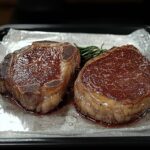
Ribeye Steak: The Ultimate Guide to Cooking Perfection
- Total Time: 60 minutes
- Yield: 2 servings 1x
Description
Perfectly seared and basted ribeye steak, cooked in a skillet with garlic, rosemary, and thyme. Juicy, flavorful, and restaurant-quality!
Ingredients
Scale- 2 (12-16 ounce) Ribeye Steaks, about 1.5 inches thick
- 2 tablespoons Olive Oil, extra virgin
- 2 tablespoons Unsalted Butter
- 4 cloves Garlic, minced
- 2 sprigs Fresh Rosemary
- 2 sprigs Fresh Thyme
- 1 teaspoon Kosher Salt, or to taste
- 1 teaspoon Black Pepper, freshly ground, or to taste
- Optional: 1/4 cup Beef Broth or Red Wine (for deglazing the pan)
Instructions
- Prepare the Steaks: Pat the ribeye steaks dry with paper towels. Season both sides generously with kosher salt and freshly ground black pepper. Place the seasoned steaks on a wire rack set over a baking sheet and let them rest at room temperature for at least 30 minutes, or up to an hour.
- Heat the Skillet: Place a heavy-bottomed skillet (cast iron is ideal) over high heat. Let it get screaming hot, almost smoking.
- Add the Oil: Add the olive oil to the hot skillet.
- Sear the Steaks: Carefully place the steaks in the hot skillet, making sure not to overcrowd the pan. Sear the steaks for 3-4 minutes per side, without moving them, until a deep, dark brown crust forms.
- Reduce Heat and Add Flavor: Reduce the heat to medium. Add the butter, minced garlic, rosemary sprigs, and thyme sprigs to the skillet.
- Baste the Steaks: Tilt the skillet slightly and use a spoon to continuously baste the steaks with the melted butter, garlic, and herb mixture. Baste for about 2-3 minutes per side, or until the steaks reach your desired level of doneness.
- Check the Temperature: Use a meat thermometer to check the internal temperature of the steaks.
- Rare: 125-130°F
- Medium-Rare: 130-135°F
- Medium: 135-145°F
- Medium-Well: 145-155°F
- Well-Done: 155°F+ (not recommended)
Remove from heat a few degrees before desired doneness.
- Optional: Deglaze the Pan: After removing the steaks, pour in the beef broth or red wine and scrape up any browned bits from the bottom of the skillet. Let the sauce simmer for a minute or two, until it thickens slightly.
- Rest the Steaks: Transfer the steaks to a clean cutting board and tent them loosely with foil. Let them rest for at least 10 minutes, or even up to 15 minutes.
- Slice and Serve: After resting, slice the steaks against the grain into 1/4-inch thick slices.
- Serve with Pan Sauce (Optional): Drizzle the pan sauce over the sliced steaks.
- Garnish and Enjoy: Garnish with fresh herbs and serve immediately.
Notes
- Choosing the Steak: Look for ribeye steaks that are well-marbled with fat.
- Don’t Overcrowd: Cook steaks in batches if needed.
- Meat Thermometer: Use a meat thermometer for accurate doneness.
- High Heat: Don’t be afraid of high heat for searing.
- Resting is Key: Resting the steaks is crucial for juiciness.
- Experiment: Feel free to experiment with different herbs and spices.
- Reverse Sear: Consider the reverse sear method for even cooking.
- Dry Brining: Dry brining enhances flavor and moisture.
- High Smoke Point Oil: Use avocado or grapeseed oil for high-heat searing.
- Prep Time: 10 minutes
- Cook Time: 15 minutes


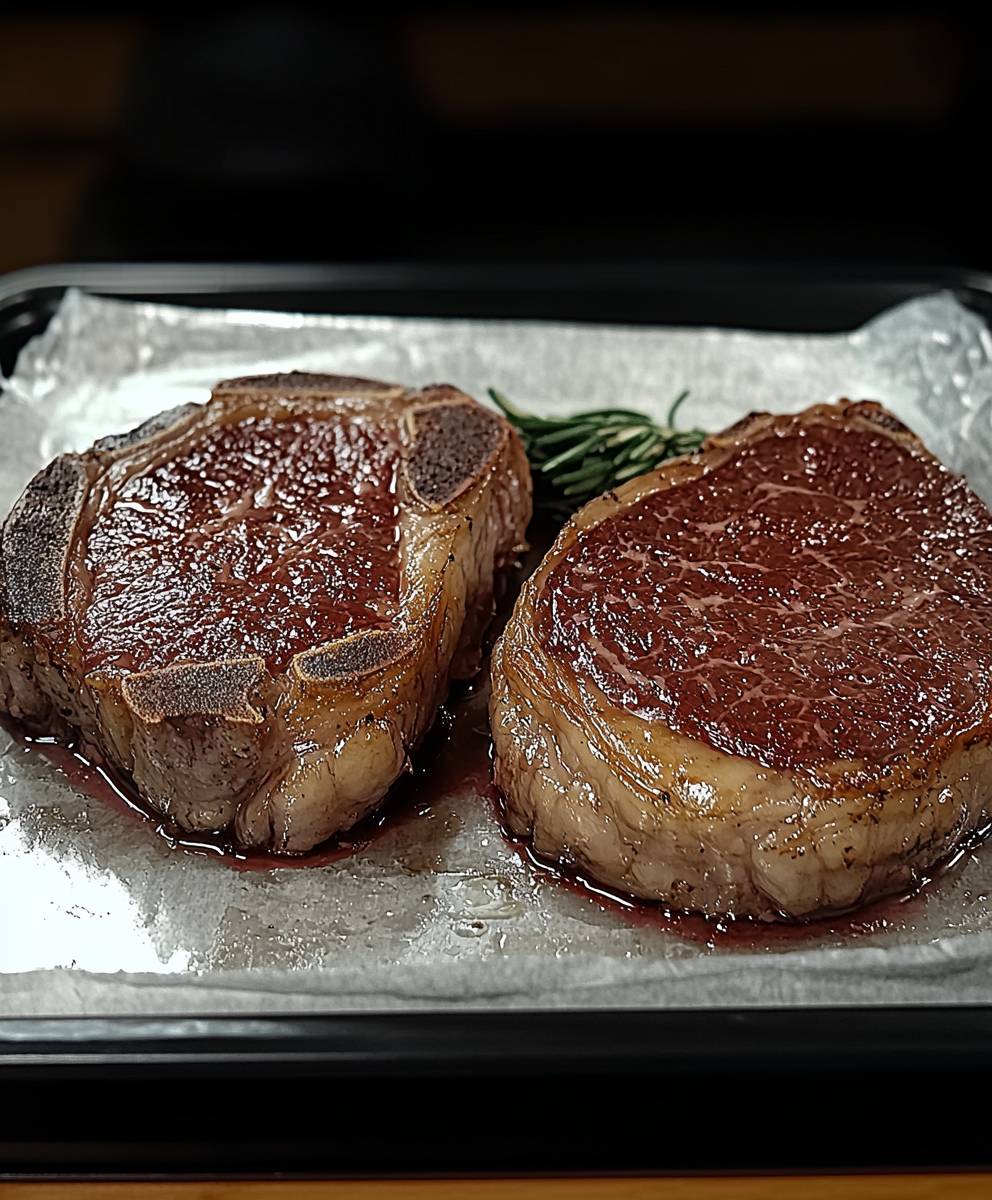
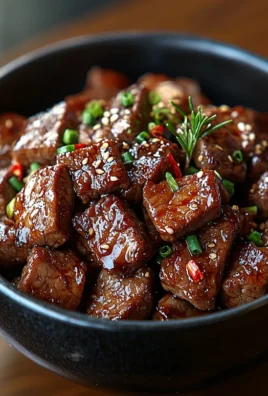
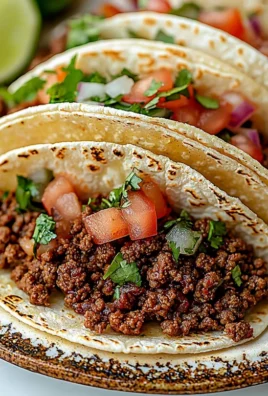

Leave a Comment